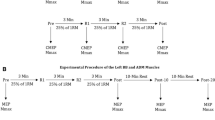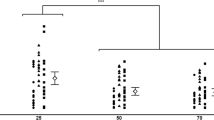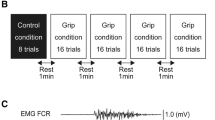Abstract
Purpose
The purpose of this study was to clarify the effect one-sided skeletal muscle contraction has on the circulatory system, spinal α-motoneuron excitability, and somatosensory-system-evoked potential.
Method
Nine healthy males maintained tension at 10, 20, and 30% of maximal voluntary contraction in static gripping in right hand. Heart rate, ln high frequency (HF), blood pressure (BP), F-wave, and somatosensory-evoked potential (SEP) were recorded during gripping task. BP, F-wave and SEP were recorded from left hand (contralateral side from contracting side).
Result and conclusion
There were significant main effects of contractions strength on heart rate (0%: 68.2 ± 6.8 bpm, 10%: 67.6 ± 7.4 bpm, 20%: 69.7 ± 8.5 bpm, 30%: 73.7 ± 9.3 bpm, F3.24=9.18, P < 0.01), systolic BP (0%: 127.7 ± 15 mmHg, 10%: 136.2 ± 13.5 mmHg, 20%: 136.2 ± 13.5 mmHg, 30%: 140.0 ± 17.1 mmHg, F3.24=23.93, P < 0.01), diastolic BP (0%: 69.3 ± 8.5 mmHg, 10%: 76.9 ± 11.1 mmHg, 20%: 79.9 ± 12.5 mmHg, 30%: 86.2 ± 14 mmHg, F3.24=17.09, P < 0.01), and F-wave appearance rate (0%: 29.7 ± 15.6%, 10%: 39.3 ± 20.5%, 20%: 47.5 ± 22.9%, 30%: 55.2 ± 21.8%, F3.24=14.04, P < 0.01). For the ln HF (0%: 5.9 ± 0.6, 10%: 6.3 ± 0.9, 20%: 6.3 ± 1.3, 30%: 6.0 ± 1.0, F3.24=2.43, P = 0.08), F-wave latency (0%: 29.6 ± 1.7 ms, 10%: 26.9 ± 2.1 ms, 20%: 26.5 ± 3.6 ms, 30%: 26.9 ± 2.3 ms, F3.24=0.11, P = 0.96), F-wave amplitude (0%: 2.0 ± 0.9%, 10%: 2.2 ± 0.9%, 20%: 2.3 ± 0.7%, 30%: 2.8 ± 1.1%, F3.24=2.80, P = 0.06), and N20 amplitude (0%: 3.9 ± 1.7 µV, 10%: 3.7 ± 1.7 µV, 20%: 3.9 ± 1.7 µV, 30%: 3.9 ± 1.8 µV, F3.24=0.61, P = 0.62), between the conditions. We conclude that regulation of the circulatory system and motor system has a limited effect on sensory input.




Similar content being viewed by others
Abbreviations
- ANOVA:
-
A one-way analysis of variance
- EMG:
-
Electromyography
- HF:
-
High frequency
- ln:
-
Natural logarithms
- MVC:
-
Maximum voluntary contraction
- SD:
-
Standard deviation
- SEP:
-
Somatosensory-evoked potential
References
Allison T, McCarthy G, Wood CC, Darcey TM, Spencer DD, Williamson PD (1989) Human cortical potentials evoked by stimulation of the median nerve. I. Cytoarchitectonic areas generating short-latency activity. J Neurophysiol 62:694–710
Angel RW, Boylls CC, Weinrich M (1984) Cerebral evoked potentials and somatosensory perception. Neurology 34:123–126
Bocker KB, Forget R, Brunia CH (1993) The modulation of somatosensory evoked potentials during the foreperiod of a forewarned reaction time task. Electroencephalogr Clin Neurophysiol 88:105–117
Burke D, Adams RW, Skuse NF (1989) The effects of voluntary contraction on the H reflex of human limb muscles. Brain 112(Pt 2):417–433
Cheron G, Borenstein S (1987) Specific gating of the early somatosensory evoked potentials during active movement. Electroencephalogr Clin Neurophysiol 67:537–548
Clancy JA, Johnson R, Raw R, Deuchars SA, Deuchars J (2014) Anodal transcranial direct current stimulation (tDCS) over the motor cortex increases sympathetic nerve activity. Brain Stimul 7:97–104
Cohen LG, Starr A (1985) Vibration and muscle contraction affect somatosensory evoked potentials. Neurology 35:691–698
Green D, Cheetham C, Mavaddat L, Watts K, Best M, Taylor R, O’Driscoll G (2002) Effect of lower limb exercise on forearm vascular function: contribution of nitric oxide. Am J Physiol Heart Circ Physiol 283:889–907
Hagbarth KE, Vallbo AB (1968) Discharge characteristics of human muscle afferents during muscle stretch and contraction. Exp Neurol 22:674–694
Hajduczok G, Hade JS, Mark AL, Williams JL, Felder RB (1991) Central command increases sympathetic nerve activity during spontaneous locomotion in cats. Circ Res 69:66–75
Hultborn H, Pierrot-Deseilligny E (1979) Changes in recurrent inhibition during voluntary soleus contractions in man studied by an H-reflex technique. J Physiol 297:229–251
Mitchell JH, Reeves DR Jr, Rogers HB, Secher NH, Victor RG (1989) Autonomic blockade and cardiovascular responses to static exercise in partially curarized man. J Physiol 413:433–445
Nishihira Y, Araki H, Ishihara A (1990) Suppression of cerebral evoked potentials preceding rapid reaction movement. J Sports Med Phys Fit 30:291–296
Rivner MH (2008) The use of F-waves as a probe for motor cortex excitability. Clin Neurophysiol 119:1215–1216
Saito M, Mano T, Iwase S (1990) Changes in muscle sympathetic nerve activity and calf blood flow during static handgrip exercise. Eur J Appl Physiol Occup Physiol 60:277–281
Seals DR, Victor RG (1991) Regulation of muscle sympathetic nerve activity during exercise in humans. Exerc Sport Sci Rev 19:313–349
Silber DH, Sinoway LI, Leuenberger UA, Amassian VE (2000) Magnetic stimulation of the human motor cortex evokes skin sympathetic nerve activity. J Appl Physiol 88:126–134
Staines WR, Brooke JD, Cheng J, Misiaszek JE, MacKay WA (1997) Movement-induced gain modulation of somatosensory potentials and soleus H-reflexes evoked from the leg. I. Kinaesthetic task demands. Exp Brain Res 115:147–155
Taylor JA, Hand GA, Johnson DG, Seals DR (1992) Augmented forearm vasoconstriction during dynamic exercise in healthy older men. Circulation 86:1789–1799
Tinazzi M, Zanette G, La Porta F, Polo A, Volpato D, Fiaschi A, Mauguiere F (1997) Selective gating of lower limb cortical somatosensory evoked potentials (SEPs) during passive and active foot movements. Electroencephalogr Clin Neurophysiol 104:312–321
Tinazzi M, Fiaschi A, Mauguiere F, Manganotti P, Polo A, Bonato C, Zanette G (1998) Effects of voluntary contraction on tibial nerve somatosensory evoked potentials: gating of specific cortical responses. Neurology 50:1655–1661
Zhou S (2000) Chronic neural adaptations to unilateral exercise: mechanisms of cross education. Exerc Sports Sci Rev 28:177–184
Acknowledgements
This work was supported by JSPS KAKENHI Grant Number JP 15K16420.
Author information
Authors and Affiliations
Contributions
TT, HY and SO conceived and designed the research. KS and MM conducted the experiments. TT and KS analyzed the data. TT wrote the manuscript. All authors read and approved the manuscript.
Corresponding author
Ethics declarations
Conflict of interest
The authors declare that they have no conflict of interest.
Additional information
Communicated by Toshio Moritani.
Rights and permissions
About this article
Cite this article
Takahara, T., Yamaguchi, H., Seki, K. et al. Effect of circulatory system response to motor control in one-sided contractions. Eur J Appl Physiol 118, 1773–1780 (2018). https://doi.org/10.1007/s00421-018-3907-y
Received:
Accepted:
Published:
Issue Date:
DOI: https://doi.org/10.1007/s00421-018-3907-y




